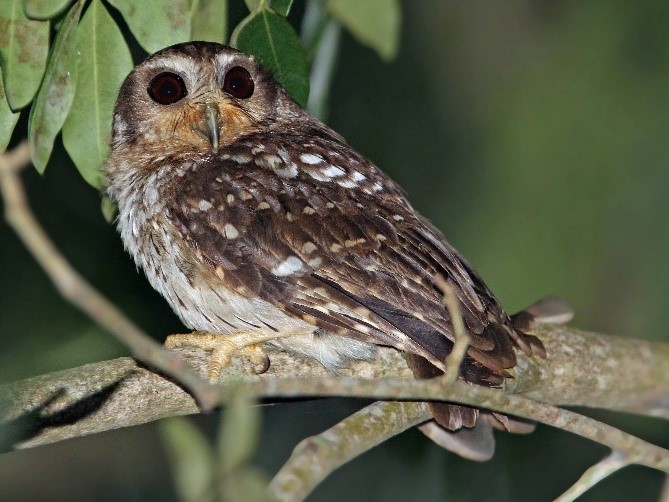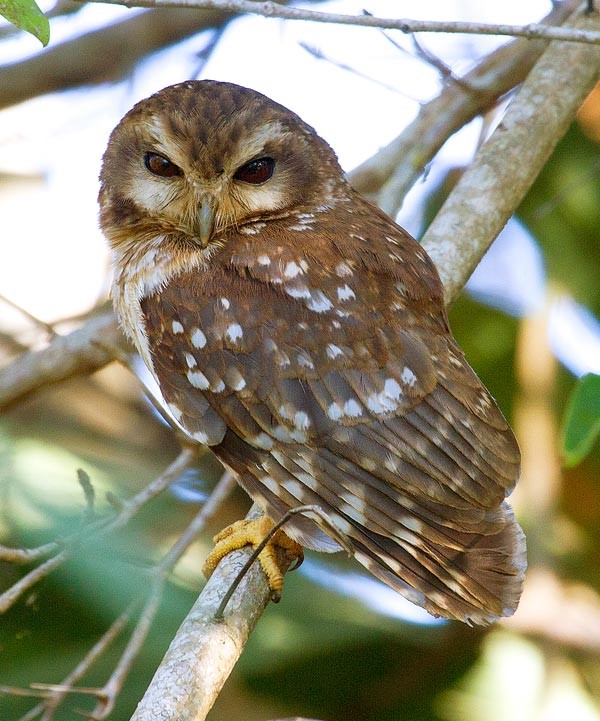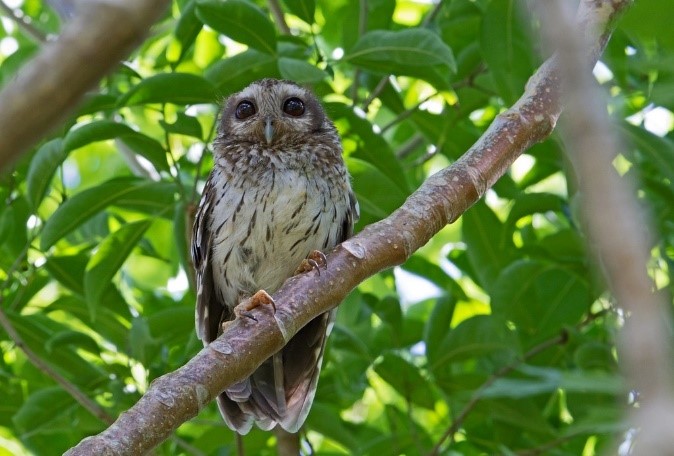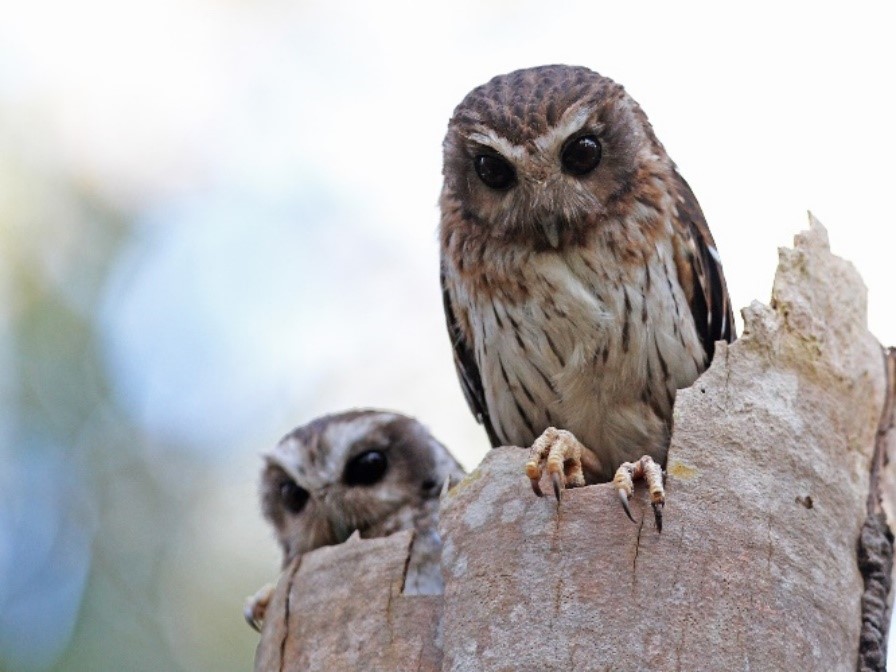Birdfinding.info ⇒ Fairly common across much of Cuba, but its nocturnal habits make it difficult for visitors to find without knowledge of a nest location or other stakeout. There is usually a well monitored pair at Bermejas. Other sites where it can sometimes be found include the Guanahacabibes Peninsula, Viñales, Soplillar, Finca La Belén, and Topes de Collantes National Park.
Bare-legged Owl
Margarobyas lawrencii
Endemic to Cuba and the Isle of Youth, where it is widely distributed in forests, thickets, and semiopen areas with limestone outcrops.
Identification
A small earless owl with large dark eyes and pale, thick, bushy eyebrows, and unfeathered yellow or orange legs.
The upperparts are mostly dark-brown with white spots.

Bare-legged Owl, showing typical coloration. (Finca La Belén, Camagüey, Cuba; March 2, 2018.) © Christoph Moning
The underparts are whitish with long, thin streaks and an irregular brownish or rusty collar across the throat and upper chest.
The eyes usually appear all-dark, but in strong natural light they appear reddish-brown.

Bare-legged Owl, showing bare legs and bushy eyebrows. (Bermejas Wildlife Refuge, Matanzas, Cuba; November 28, 2014.) © Dubi Shapiro
Voice. Typical call is a rapid series of about 10 to 20 soft, percussive hoots that accelerates in a bouncing-ball pattern:
Notes
Monotypic species and genus.
More Images of the Bare-legged Owl

Bare-legged Owl, a somewhat reddish individual. (Soplillar, Matanzas, Cuba; March 2013.) © Ian Merrill

Bare-legged Owl, showing darker brown upperparts than most. (Bermejas Wildlife Refuge, Matanzas, Cuba; December 6, 2014.) © Richard L. Becker

Bare-legged Owl, showing larger white spots than most. (May 28, 2019.) © Karlos Ross

Bare-legged Owl, showing paler brown upperparts than most. (Bermejas Wildlife Refuge, Matanzas, Cuba; February 8, 2016.) © Dušan M. Brinkhuizen

Bare-legged Owl, showing rusty collar on throat and upper chest. (Ciénaga de Zapata National Park, Cuba; November 13, 2013.) © Alan Van Norman

Bare-legged Owl, showing orange-brown eyes. (Bermejas Wildlife Refuge, Matanzas, Cuba; March 6, 2018.) © Christoph Moning

Bare-legged Owl. (Fray Benito, Holguín, Cuba; February 25, 2019.) © Ian Morton

Bare-legged Owl, ventral view. (Soplillar, Matanzas, Cuba; April 6, 2014.) © Greg Griffith
References
BirdLife International. 2016. Margarobyas lawrencii. The IUCN Red List of Threatened Species 2016: e.T22688883A93210507. https://dx.doi.org/10.2305/IUCN.UK.2016-3.RLTS.T22688883A93210507.en. (Accessed December 8, 2023.)
eBird. 2019. eBird: An online database of bird distribution and abundance. Cornell Lab of Ornithology, Ithaca, N.Y. http://www.ebird.org. (Accessed December 8, 2023.)
Enríquez, P.L., K. Eisermann, H. Mikkola, and J.C. Motta-Junior. 2017. A Review of the Systematics of Neotropical Owls (Strigiformes), Neotropical Owls: Diversity and Conservation (P.L. Enríquez, ed.). Springer International Publishing, Cham, Switzerland.
Garrido, O.H, and A. Kirkconnell. 2000. Field Guide to the Birds of Cuba. Cornell University Press, Ithaca, N.Y.
Kirwan, G.M., A. Levesque, M. Oberle, and C.J. Sharpe. 2019. Birds of the West Indies. Lynx Edicions, Barcelona.
König, C., and F. Weick. 2008. Owls of the World (Second Edition). Yale University Press.
Mikkola, H. 2013. Owls of the World: A Photographic Guide (Second Edition). Firefly Books, London.
Navarro, N. 2015. Field Guide to the Endemic Birds of Cuba. Ediciones Nuevos Mundos, St. Augustine, Florida.
Raffaele, H., J. Wiley, O. Garrido, A. Keith, and J. Raffaele. 1998. A Guide to the Birds of the West Indies. Princeton University Press, Princeton, N.J.
Xeno-Canto. 2019. Bare-legged Owl – Margarobyas lawrencii. https://xeno-canto.org/species/Margarobyas-lawrencii. (Accessed October 21, 2019.)
